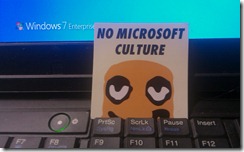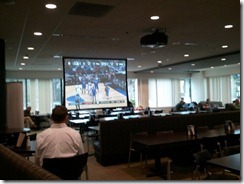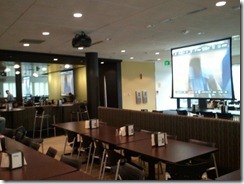Myths of Microsoft Culture
From time to time, I hear interesting anecdotes from colleagues or friends outside Microsoft, telling me a story about what it’s like to work at Microsoft. Often these stories are placed into a comparative context, as in: our culture is different than Microsoft, because we do XYZ and Microsoft does ABC.
Of course, there is rarely an opportunity, in that conversation, to provide feedback on the basic assumption… that the person speaking has any clue at all about what it’s like to work in the innovation factory. On one occasion, I did get the opportunity to ask about the source of their impressions about Microsoft, and I heard simply “everyone knows that.” Bull-chips.
I’d like to examine a few myths about Microsoft’s corporate culture, and provide some anecdotes from my own personal experience that may provide a little insight. Keep in mind that I’m not a Microsoft lifer. I’m in my second stint at Microsoft, and have been there for about eight years now, but previously I’ve worked at: IBM Boca Raton, Racal Datacomm, American Express SROC, two small dot-coms (Fine.com and Acadio), various agencies of the State of Washington (Labor and Industries, Department of Licensing, Department of Health and Human Services), Los Angeles county, a tiny medical software company (DBS), the University of Tennessee Computing Center, and a couple of small retail jobs. In other words, I’ve been a bit of a wanderer in my life, and I’ve seen a wide array of different “corporate cultures” at play.
Myth: Microsoft employees work around the clock
Microsoft earned this reputation because our products mushroomed in complexity before our development processes had a chance to catch up. Microsoft Windows and Microsoft Office became really big products at a time when there was no science, no literature, no guidance anywhere to inform us on the best way to build such big products.
We’ve solved it.
In all areas of the company, from product groups to sales teams, from operational divisions to support, Microsoft employees have, by and large, normal lives. Sure, the software business is a creative business, and sometimes estimates are wrong. Sometimes, a small team has to work really hard to hit a deadline that another small team depends on. In exchange for that risk, there is the freedom for those small teams to be innovative… no one is telling them what to do, or how to create the future. It is a balance, but one in which most employees thrive in.
Myth: Microsoft employees put work above personal lives
Absolute nonsense. As an Enterprise Architect, I work with a very wide array of folks, way more than the average. While a “typical” employee may interact daily with 10 people, my number is closer to 50, and I’m friendly and social with everyone.
Here’s what I’ve seen: bicycle enthusiasts telling me about a mountain-biking trail they just discovered, Opera fans raving about the new Seattle Opera production, parents talking about visits to their children’s schools, volunteers sharing their efforts to help the homeless or teach children to read, and even a co-worker whose dog was part of the AKC/Eukanuba National Championship dog show. My co-workers live full and rich lives, getting married, raising children, and engaging in communities around the world. That’s the way it should be.
Myth: Microsoft doesn’t care about anything except money
This one hurts, but I’ve heard it. I’ve working in many different organizations, and I’ve never seen or heard of a company that takes greater pride in giving back to the community than Microsoft.
When Bill Gates left Microsoft to become the world’s biggest philanthropist, some folks in the business community were surprised, but we were not. Bill always emphasized the importance of giving, and charity is deep in the culture of Microsoft. (Before she died, Bill Gates’ mother was a senior member of the United Way of King County. Compassion runs deep in the Gates family, and it runs deep in Microsoft) Our annual fund drives for charity are large and very visible, but where other companies may consider that enough, at Microsoft, it’s only the beginning.
This fall, I sat in a meeting with the CTO and all of his directs as he had each of his senior leaders stand up and describe their favorite charity and why they are passionate about it. Every year, my department takes the day off and joins up with others to volunteer as a group at a local charity. (This last year, we gave time to a shelter for troubled youth… the year before that, to a charity that trains work dogs for disabled people). There is no pressure to give, but more than ample support for the message: giving is important and we celebrate the work that non-profit agencies do. We have internal software tools for helping employees to plan their giving, and you can specify monthly deductions from your paycheck to be sent to the charity of your choice, matched 100% by the company. Every hour you spend at a charity is matched by a cash contribution by the company as well.
During each major natural disaster, there are dozens of fund-raising events that spring up, completely unplanned but totally supported, to raise money for the needy. (Including events, at the moment, to help victims of the earthquake and tsunami in Japan). On the bulletin boards around the company, next to postings of someone’s garage sale, or a house-cleaning service, there are always posters describing some charitable cause or another (often supporting education for disadvantaged children around the world).
Microsoft employees care. This is one of the aspects of Microsoft culture that I love.
Myth: Microsoft burns you out
People burn out of everything. I once knew a guy who spent most of his time on the sofa after burning out of doing road construction work. That said, in the early days, when we were still figuring out how to release large software systems, I’m sure that we had more burnout than other companies. Creative people + seemingly endless hours can do that to anyone.
That aspect of Microsoft’s past is gone. How do I know? Because Microsoft asks, and anyone can read the results.
Every year, every employee of Microsoft is asked to fill out a detailed 360-degree review of themselves, their team, their managers (all the way up) and the company. The data is collected by an independent firm to insure absolute privacy. We are honest about ourselves and each other. The results are available, and we USE the data to improve. Managers are rewarded on the basis of their “Workplace Health Index” (WHI) and those scores propagate upward, so that senior managers have incentive to mentor and train the managers below them.
Burnout shows up. Impending burnout shows up. WHI scores dip and specific questions turn up that indicate a potential for burnout. Managers that burn people out are retrained, and people notice when the workers below a new manager all start to shift to other teams. I’ve even occasionally heard the phrase “rats off a sinking ship”. But it doesn’t happen that often. Not any more. We’ve gotten better at promoting, training, and developing the leaders within the company. As a result, the company’s turnover rate has dropped. That said, if a manager sucks, his team will leave him or her for other opportunities in the company.
And this highlights another aspect of the culture: truly active support, by the HR department, to allow people to move from one team to another. If you are unhappy with your position, or your interests have changed, or you want to try on a different set of skills, you are not only free to move; you are encouraged to move to another spot. The company is large, the needs are varied, and the people are friendly. There may come a time when you want a new job. You don’t have to leave Microsoft to get it.
In just the past year: An architect that I’ve worked with for years just moved over to lead a team of business folks in his operations division. A talented developer that I enjoy working with moved from the office of the CTO to the product group (SQL Server). A senior developer who was also a good speaker moved from software development to software evangelism (yep, that’s a title at Microsoft: software evangelist). Our chief Enterprise Architect, my manager, is about to embark on a new architecture role in the Interactive Entertainment Business (think: XBOX). We shift all the time.
In this environment, burnout just isn’t that much of a problem anymore. If ‘softies burned out all the time, how is it that so many of my peers have been at the company for over ten years?
Myth: Microsoft is a dreary place, with no opportunities for fun
This one is almost laughable. Does your workplace offer you professional-quality soccer fields, baseball fields, basketball courts, beach volleyball courts, regular fully-funded “morale” events, social groups by interest, amazing Christmas parties (in a local downtown hotel, with drinks, food, dancing, entertainment, roaming photographers, etc.), a café complex that includes about a dozen local restaurants, an in-house bicycle shop, game rooms, video games in the common areas, pool tables, XBOX consoles plugged in to huge projection-size televisions (some with Kinect controllers), art work in every hallway and corridor (including some art pieces that are truly amazing, like the four-story light array in one of the Game Studio buildings), and open meeting areas for spontaneous conversation and collaboration?
What about chances to be really innovative for creative types? We have groups of people in the company that have formed around the meme of “individual innovation” including the “Microsoft Garage” group (anyone can join) that regularly gets together to work on fun side-projects. I’m in that group. In the past year, the garage has done everything from helping people to create nifty bits of software to building an entry in the Red Bull Flugtag!
Myth: Microsoft doesn’t innovate
Every year, Microsoft hosts an internal conference, just for full time employees, where the rather large Microsoft Research organization sets up booths and the researchers present their ideas directly to the rest of the company. In case you’ve never heard of Microsoft Research, this often-unheralded division of Microsoft is a well-funded world-wide pure-research organization. Fascinating and useful innovations have come out of MSR as well as basic computer science research that universities around the world leverage in developing the new ideas of the future.
This unique organization brings together some of the greatest minds in computer science to fund basic research, at the corporate level, not only to create new ideas but to bring them to life in the products and services of Microsoft. Some of the examples of recent innovations in Microsoft products that resulted from MS Research are listed here.
Myth: Microsoft employees are in it for the money, not the love of innovation
In the past, when the stock was shooting through the roof and stock options amounted to the majority of Microsoft employee benefits, a large number of people came to Microsoft thinking they could get rich here. A few did. Those days are gone. Now we make money the old-fashioned way… we earn it. Guess what… the greedy ones have left. Many moved to dotcoms. More recently, the remaining ones moved to Apple, Google and others promising riches. Many were dead weight. Good riddance.
The people who are passionate about innovation are very much still here, myself included. We stayed because this is the best place on earth for an innovator to build something that actually works for millions of people, where software has fewer bugs than features, and where viruses are patched right away rather than months or years later.
That said, let’s not discount the value of being compensated according to your value. Personally, I think I’m paid fairly at Microsoft. My salary is competitive. I get the best healthcare in the State of Washington through Microsoft’s well-funded and well run health insurance program. There are other perks too, including paid time off for a new baby (for both the father and the mother), adoption assistance, health club membership, life and disability insurance, and more. Microsoft is even paying for me to lose a few pounds. Of course, Microsoft still has plenty of millionaire employees. (I park next to a Lotus sports car every day). But these days, it’s mostly just a great place to work.
And yes, the fresh-ground coffee and soda pop is free.
Myth: Microsoft is a slow culture, plodding along at a slow pace
Which Microsoft? Seriously.
Some parts of Microsoft are involved with releasing really large and complex software products. Our customers don’t WANT Microsoft to rush a new version of Windows or Office to market every year. (Proof in point: a lot of people are still using Windows XP… 10 years old). That isn’t a slow pace. That is an intentional, rational pace that insures that new products have enough features for customers to justify an upgrade. The free service packs and bug fixes come out every month.
On the other hand, if you look at the divisions that are focused on consumer, hosted, and cloud services, we are releasing new services and capabilities at a rate that is as fast, or faster, than competitors like Amazon and Salesforce combined. In the past few years, Microsoft has released cloud services in infrastructure, management, office applications, CRM, and even content delivery. Many are free. (I use my SkyDrive daily). Some are already market leaders (Microsoft’s Content Delivery Network, competing with Akamai and about a hundred other companies, is already one of the top CDNs in the world in terms of traffic and performance).
Microsoft competes in online advertising, search, and hosted personal services like e-mail and calendar. We are investors in Facebook and a cable television network (MSNBC). We have wildly popular retail stores opening up in shopping malls around the country, each carrying thousands of products with friendly enthusiastic staff to guide you. Microsoft and it’s partners roll out new game and entertainment titles continuously, and the Kinect controller for the XBOX is now in the Guinness Book of World Records for the fastest selling new consumer electronics product in history.
Culturally: time-to-market counts. Now more than ever. It shows in the way teams are structured, the way projects are aligned, the work that people do, the priorities that managers operate under, and the measures on senior management scorecards.
Reality: Microsoft Is An Excellent Place to Work
I hit on many of the cultural myths I’ve seen play out. I was motivated to write this post after hearing that another tech company nearby handed out stickers to all of their employees that said “No Microsoft Culture ”. My response: you don’t know what you’re missing.
I’ve been working at Microsoft for the past eight years. I expect to spend another decade at Microsoft (unless I get some excellent career-building offer from somewhere else). I’ve grown quite a bit in these eight years. At Microsoft, I have a chance to contribute, to help change the world. Some folks do that by being part of a small energetic company. I’ve chosen a large, dynamic, energetic, fast-moving, caring, compassionate, continuously improving company… one with flaws, but one that cares about addressing those flaws.
Last word: March Madness
OK, I have to share this bit, because it says so much about Microsoft. Below are two photos taken at the same time from different angles. They are taken in the cafeteria of Building 122 a few days ago. In these photos, you can see large screens showing the College Basketball playoffs (affectionately known as “March Madness”). In the photo on the left, there is a good shot of one of the screens. In the photo on the right, if you look carefully, you can make out the fact that there are three screens running at the same time.
Two things to note:
- If you want to watch the games, you don’t have to hide at your desk. Join your co-workers in the café, sip some coffee or have a snack, and watch the game.
- Not a big crowd. This day, there was one person, watching three huge screens. Where is everyone else? We are busy getting our work done so we can get home to be with family. We have the option to goof off, but we don’t take it, because we enjoy the work we do.


